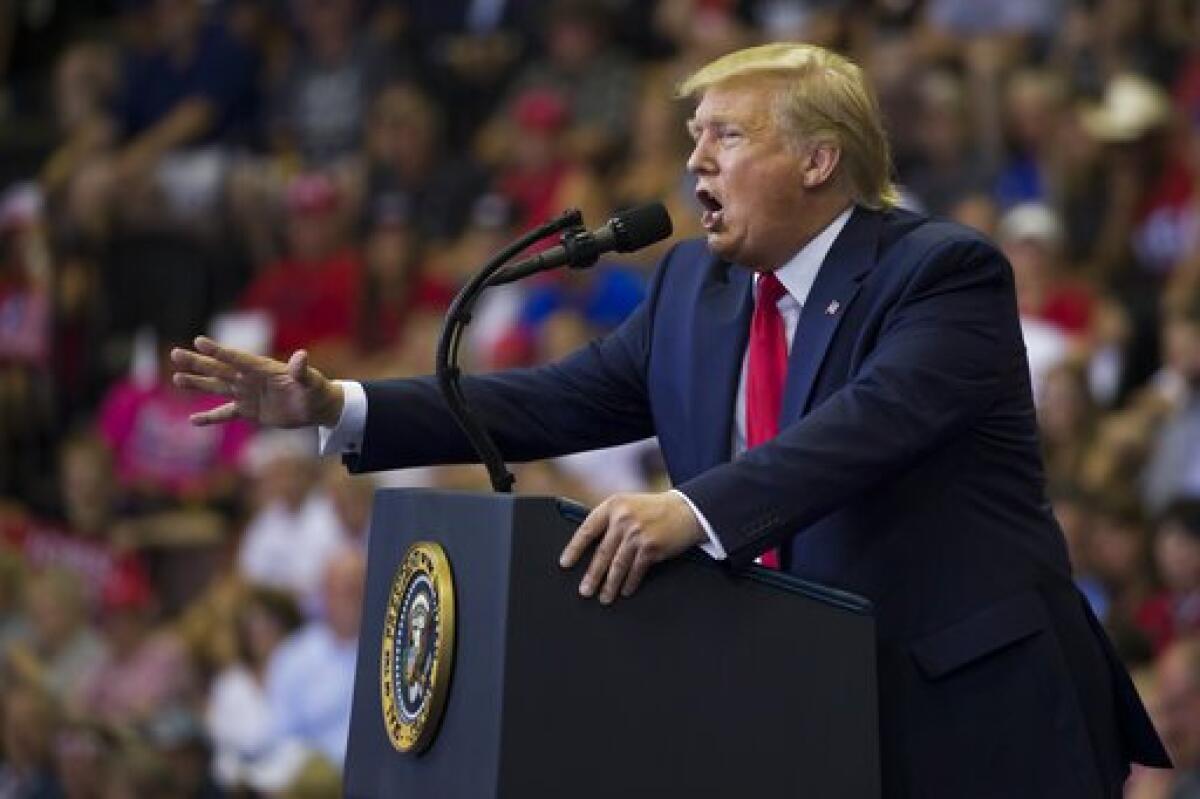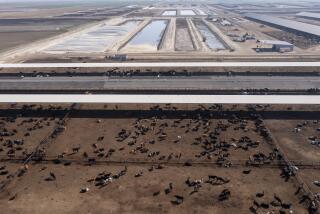It’s not just Baltimore; Trump is running against America’s cities

He was born in Queens and lives on Fifth Avenue. His skyscrapers dot city skylines on several continents. But President Trump is increasingly intent on disparaging urban areas, depicting them as blighted and overrun by criminals and homelessness — all part of a divisive reelection strategy heading into 2020.
Trump’s denigration of cities is part of an effort to animate a base of rural, mostly white supporters while depressing minority turnout in places like Milwaukee, Detroit and Philadelphia — a repeat of the two-pronged strategy that helped him to a surprising electoral college victory in 2016 and could be determinative again four years later.
“No one has paid a higher price for the far-left destructive agenda than Americans living in our nation’s inner cities,” Trump said Thursday night at a rally in Cincinnati, drawing cheers from the mostly white crowd. “We send billions and billions and billions for years and years, and it’s stolen money, and it’s wasted money.”
“For 100 years it’s been one party control, and look at them,” he continued. “We can name one after another, but I won’t do that because I don’t want to be controversial.”
In reality, the country’s largest urban areas are major engines of the national economy and generate more tax money than they receive from the federal government. By contrast, most rural areas receive more from Washington than they generate.
The president singled out California and two of its largest cities, commenting on a homelessness problem that he laid at the feet of the state’s leaders.
“Nearly half of all the homeless people living in the streets in America happen to live in the state of California. What they are doing to our beautiful California is a disgrace to our country. It’s a shame,” he said.
“Look at Los Angeles with the tents, and the horrible, horrible disgusting conditions. Look at San Francisco, look at some of your other cities,” Trump added.
Trump’s administration has not made homelessness a priority and has offered no new policy ideas for dealing with the problem.
After a skirmish in the crowd, as Trump supporters swarmed around a small group of protesters who had unfurled a sign that read “Immigrants Built America,” the president took the opportunity to punctuate his chosen message.
“Cincinnati, do you have a Democrat mayor?” Trump asked the crowd. “Well, that’s what happens.”
Last weekend, Trump tweeted more than 30 times about Baltimore, the nation’s 30th largest city, calling it a “very dangerous & filthy place” where “no human being would want to live.”
He blamed Rep. Elijah Cummings, the Democratic chairman of the House Oversight Committee that is investigating the administration on multiple fronts, and described his district, which includes parts of Baltimore as well as its suburbs, as a “disgusting, rat- and rodent-infested mess.”
A Trump campaign aide defended the president against critics who called those statements racist.
“It’s notable that no one has challenged the President’s descriptions of the problems in Baltimore and other cities. Critics would rather focus on the word ‘infested,’ which is the very same word Congressman Cummings used to describe his own city’s drug problems in a congressional hearing 20 years ago,” said Tim Murtaugh, a spokesman for Trump’s reelection campaign.
“After all this time, why hasn’t it gotten better? It’s completely legitimate to call out the leadership in cities where conditions haven’t improved decade after decade.”
“When the nation and our economy are clearly on the right track, why would we turn the country over to the same political party whose ideas have failed so many of our city residents?” Murtaugh added, noting, as the president often does, that African-American unemployment is dropping.
While Trump avoided mentioning Cummings by name at the rally Thursday night, he did assert that Baltimore’s homicide rate was higher than several Central American countries.
“I believe it’s higher than — gimme a place that you think is pretty bad,” Trump said, bringing his supporters in on the bit. “Gimme a place.” People shouted the names of American cities and foreign countries. Trump picked up on a shout of “Afghanistan.”
“I believe it’s higher than Afghanistan,” the president said.
Then on Friday morning, Trump tweeted about a recent burglary at Cummings’ home, presenting a news story that seemed to prove his point under a thin veil of “you hate to see it” empathy.
“Really bad news! The Baltimore house of Elijah Cummings was robbed. Too bad!”
Trump’s ambiguous tweet drew a bipartisan wave of rebukes.
Former United Nations Ambassador Nikki Haley, who left the administration late last year on good terms with the president, replied to the tweet Friday. “This is so unnecessary,” she wrote, adding an emoji of a perplexed face.
In running against urban centers, Trump, whose family originally became wealthy building tax-supported housing in Brooklyn and Queens, is picking up an American political tradition of appealing to rural voters by depicting cities as centers of crime and disease. In the current context, in which America’s urban population is more racially diverse than most of its rural areas, the slogans have taken on an added dimension.
“He’s talking about cities and urban areas and using it as a proxy for minorities,” said Cornell Belcher, a Democratic pollster in Washington. “He’s pretending to be benevolent, but he’s locking in the stereotype that ‘these people need us to take care of them — those people can’t govern themselves.’ It’s this white savior idea — that is as fundamentally and historically racist as it comes in this country, the idea that people of color need to be saved by the white man.”
Trump’s expressions of concern for urban communities also offer him something to point at to rebut charges of racism sparked by his comments about Cummings and his tweet telling four female Democratic members of Congress who call themselves “The Squad” to “go back” to other countries.
“It just further demonstrates how disconnected he is from reality,” said Denver Mayor Michael Hancock. “It’s really at the city level where the issues of bread-basket America are being addressed: housing, homelessness, mobility, the opioid epidemic. Cities are doing the things the federal government has failed to do.”
Even in attacking Democratic presidential hopefuls who have suggested decriminalizing the border, Trump has geared his argument toward African Americans in inner cities, suggesting that they will be the ones most hurt by more undocumented immigrants coming to the U.S.
Matt Schlapp, the chairman of the American Conservative Union and the husband of Trump 2020 campaign senior advisor Mercedes Schlapp, suggested that Democrats might be “cavalier” about their support from African American voters.
“The party is moving to open borders and that’s a disastrous policy for urban blacks,” Schlapp said. “It makes perfect sense that Trump would point that out.”
But Michael Nutter, a former two-term mayor of Philadelphia who is African American, said that all of Trump’s rhetoric is meant to obscure racism and his actual indifference to urban America, where he is unlikely to garner much support.
“He has no plan for America’s cities at all,” Nutter said. “This is just more red meat for his base. The whole presidency and the reelection will be focused on dividing the country,” he said. “That is the only way he believes he can win.”
Nutter said Trump’s “psychological warfare” aimed at depressing African-American turnout next year will have the opposite effect.
“In 2016, people just couldn’t believe that this kind of bizarro character had any possible chance,” Nutter said. “Now, I think that folks’ eyes are wide open. People are fully woke.”
More to Read
Get the L.A. Times Politics newsletter
Deeply reported insights into legislation, politics and policy from Sacramento, Washington and beyond. In your inbox three times per week.
You may occasionally receive promotional content from the Los Angeles Times.







